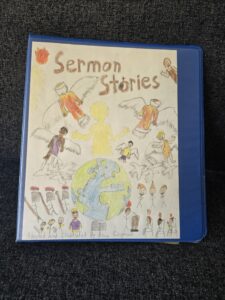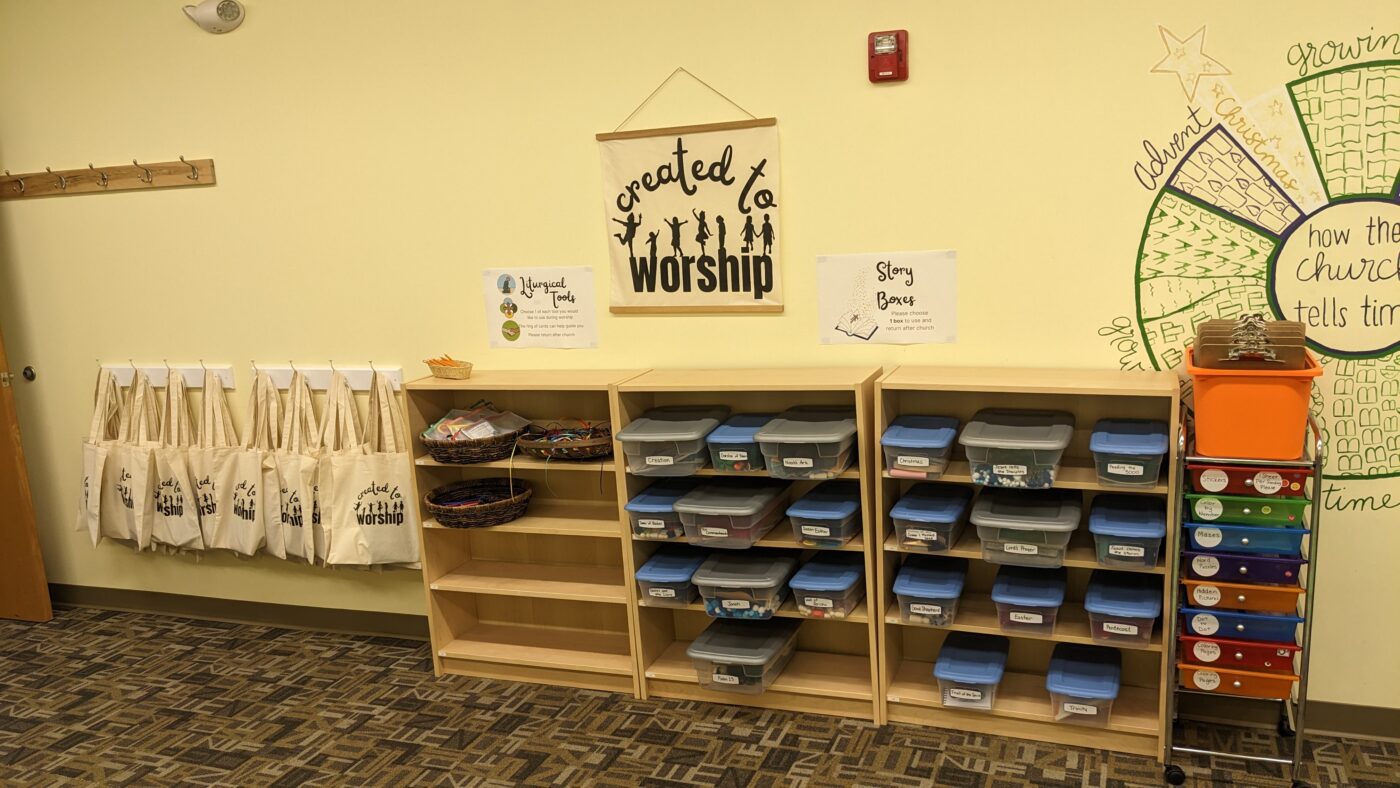Children’s Ministry Leader Kelli Dunn shares how she intentionally incorporated opportunities for play into worship services for kids.
Busy Bags, or Something More?
As programming took a break during my first summer on staff with my church, I stocked the shelves and prepared “busy bags” with this question in mind: “What toys can I find that aren’t too messy, too loud, or too big?” Read: “How can we have children in the sanctuary without making the adults realize they are there?” And, for the most part, it worked – kids strung beads on a string or put puzzles together while the adults listened to the sermon. Something about that summer never sat right with me, though. Were the kids in worship? Yes! Were the adults still able to worship? Yes! But what implicit lesson were we teaching the kids about worship?
The answer can be found within that initial question – kids are welcome in worship if they don’t leave a mess, make a lot of noise, or take up too much space. As an educator by training, there is always a nagging question in the back of my mind– what’s the goal behind what you are doing? If my goal was to minimize the impact of kids on the worship service, then I was meeting it. But if my goal was to unite as a community of believers to worship together, then we were missing the mark.
A New Standard for Playful Worship
I needed a new standard for the summer, one that focused on worshipping together and on teaching our kids (and adults) what worship was. As I participated in a Vital Worship Grant (sponsored by the Calvin Institute of Christian Worship) that focused on sacred play, I set out with some new goals, including:
- To equip parents and other adults with the language and tools to help the children understand and actively participate in each portion of the liturgy
- To encourage a playful engagement with the liturgical elements in order to grow in love for how the liturgy shapes our lives in worship and outside of it
A Shared Language for Worship

So, the last Sunday in April, I sat at the front of the church and invited people to our first “Family Meeting.” I hooked together some plastic chains while I described how the “Call to Worship” was like being woken up in the morning – it invites us to be aware of God’s presence, and we get to be joined together with other believers to the Father, Son, and Holy Spirit in worship.
I handed each child a bag of plastic chains, and they returned to their seats. This was our first “Liturgical Tool” – a tool that helps us paint a picture of a part of the liturgy so we can understand it together.
At our “Family Meeting” the following week, I handed out ribbon rings while discussing why we sing. Next, it was a small LED drawing board to represent the Call to Confession and Assurance of Pardon. By the time summer rolled around and children’s programming paused, we had built our Liturgical Toolkit while developing a shared language around how we worship and why.
“What if play, instead of being an activity to fill time and keep children occupied, becomes a place and an activity where children are able to comprehend ideas and understandings, not just in their heads but deeply in their souls, and in turn, it becomes a means of developing and nurturing the faith or spirituality of a young child?”
Mimi L. Larson and Shirley K. Morgenthaler, “The Sacred Playground: Play and a Child’s Faith” from Bridging Theory and Practice in Children’s Spirituality
Toys for Playful Worship
Now, each Sunday when the children came to church, they had options to bring them into the sanctuary, which led them into worship. They could choose from:
- Liturgical Toolkit – a bag of tangible tools (typically viewed as toys) that represent a particular portion of the liturgy, designed to help kids both understand and participate in the liturgical practice
- Story Boxes – a small box that contains items to retell or engage in a story from the Bible
- Worship Response Items – resources geared towards older kids (ages seven and up) to help draw them into worship and provide a way to respond in worship
Learning along the way
Along the way, I did learn a few things about our summer worship tools. Clear organization and labels helped the kids and parents know where to find things and how to return the items. And, I learned that spending a few minutes each week to clean up and maintain the shelves helped make them more inviting and organized.
We provide bags for kids to put the items they select in, along with some other essential tools – a pencil pouch with crayons and pencils, a clipboard for drawing, and a small pack of wikki sticks or other fidget toys.
I also had to be realistic (first with myself and then with the parents) that expecting 100% engagement wouldn’t happen – even adults aren’t engaged from start to finish; we just develop ways of hiding it. Providing choice for the Story Boxes and the Worship Response Tools kept the tools sustainable throughout the summer, as the kids weren’t coming back to the same bag or tray each week.
Good Fruit
 This past November, on my birthday, a church member presented me with a gift. It wasn’t from her, but from her 12-year-old daughter.
This past November, on my birthday, a church member presented me with a gift. It wasn’t from her, but from her 12-year-old daughter.
The gift was a binder titled “Sermon Stories” on the cover. On the left of each page was a scripture or prayer from one of our summer worship services; on the right side was a comic strip that her daughter had drawn based on the adjoining page. She had made one each week in the summer and compiled them into a book.
It even included a dedication page that said, “Thank you so much for giving me the inspiration for all of this. If you hadn’t organized activities for the kids to do during the summer, I would have just done crossword puzzles. Thank you for being such a hardworking and inspiring mentor.”
This gift was probably one of the more meaningful gifts I’ve ever received – it was an act of worship that her daughter had done weekly in the summer, using the tools provided and guided by her parents’ encouragement. As I paged through the book, I couldn’t help but wonder how this girl’s imagination of what it meant to worship would be impacted by her summer spent drawing comic strips in the sanctuary.
Guest Author
-

Kelli Dunn
Kelli Dunn taught various grades from Kindergarten to High School for over a decade and now serves as the Director of Children’s Faith Formation at her church in Milwaukee, WI. Kelli thoughtfully designs experiences that will help create a culture where children are valued and embraced as a valuable part of the church.

Comments (2)
I love this! Thanks Kelli. It’s interesting that Clare Morell’s Tech Exit book just came out and Christianity Today included a section broadly noting how technology damages the Church. It made me think of one of my pet peeves: How the use Powerpoint inhibits parents from pointing to the words of Scripture in a Bible or the words of a hymn in a hymnal to their children, especially those learning to read. I miss parents sitting with their arms around their children pointing to the words being sung or read. I miss parents intentionally passing on faith to their children in the pews period. No one can point to the words in a Powerpoint. Only readers can follow that.
I would love to know a bit more about how the objects you gave the families connected to the parts of the service you were highlighting, specifically the ribbon rings and the LED board.
Hi Cynthia!
Thanks for your thoughtful engagement with this article! You can read more about all the items Kelli includes in her liturgical toolkits here: https://faithandchildren.org/2025/05/08/hands-on-worship-for-kids-creating-a-liturgical-toolkit/
Lindsey